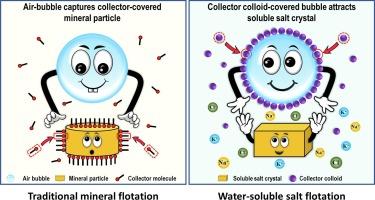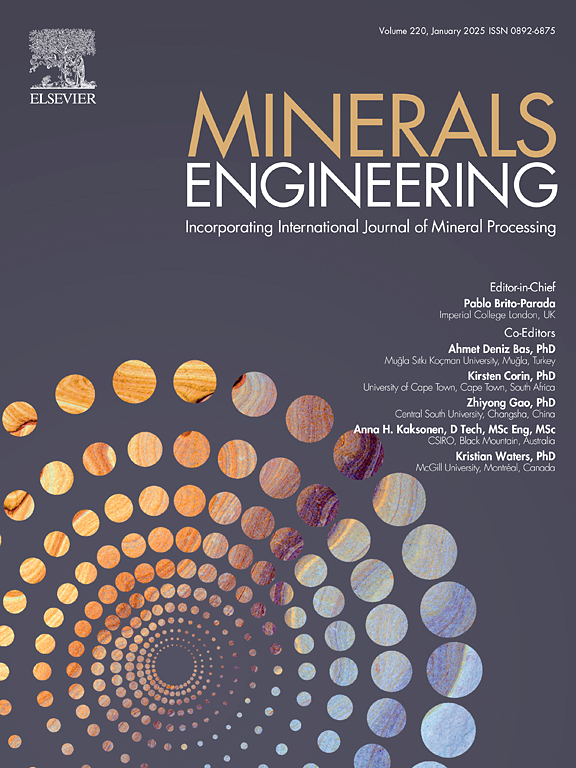可溶性矿物浮选悖论:矿物上没有捕收剂吸附迹象却提高了回收率,这表明气泡结合的捕收剂胶体与矿物颗粒之间存在胶体吸引力
IF 4.9
2区 工程技术
Q1 ENGINEERING, CHEMICAL
引用次数: 0
摘要
浮选利用气泡根据矿物表面疏水性的差异来分离矿物颗粒。需要捕收剂来选择性地疏水目标矿物的表面,以增加想要的矿物和不想要的矿物之间的表面疏水性差异。在这里,我们证明了这一经典(已确立的)原理无法描述水溶性矿物的浮选。我们使用盐水中的可溶性矿物(氯化钠和氯化钾晶体)和三种常用的捕收剂(十二烷基胺盐酸盐、十二烷基硫酸钠和月桂酸钠)进行了系统的微浮选试验,结果表明盐类矿物的浮选回收率很高,而且用 X 射线光电子能谱(XPS)检测矿物表面没有捕收剂吸附。粒度分布测量结果表明,饱和盐水中存在亚微米级的捕收剂胶体。此外,浮选回收率与测量的接触角非常吻合,这表明气泡结合的捕收胶体与盐晶体表面之间存在吸引力。这些自相矛盾的结果表明了可溶性矿物浮选的一个新原理,即气泡结合的捕收胶体与盐颗粒之间的选择性胶体吸引力使可溶性矿物得以浮选分离。本文章由计算机程序翻译,如有差异,请以英文原文为准。

Soluble mineral flotation paradox: Improved recovery with no sign of collector adsorption on minerals signifies colloidal attraction between bubble-bound collector colloids and mineral particles
Froth flotation uses air bubbles to separate mineral particles based on the difference in mineral surface hydrophobicity. Collectors are needed to selectively hydrophobize the surface of targeted minerals to augment the difference in surface hydrophobicity between wanted minerals and unwanted ones. Here, we showed that this classical (well-established) principle fails to describe the flotation of water-soluble minerals. Our systematic micro-flotation tests using soluble minerals (NaCl and KCl crystals) in brines and three popular collectors (dodecylamine hydrochloride, sodium dodecylsulfate, and sodium laurate) showed a substantial flotation recovery of the salt minerals without detected collector adsorption at the mineral surfaces by X-ray photoelectron spectroscopy (XPS). Complementary particle size distribution measurement indicated the occurrence of sub-micron collector colloids in saturated brines. Moreover, the flotation recovery agreed well with the measured contact angle, suggesting the attraction between bubble-bound collector colloids and salt crystal surfaces. These paradoxical results signify a new principle underlying the flotation of soluble minerals, i.e., the selective colloidal attraction between bubble-bound collector colloids and salt particles enables the flotation separation of soluble minerals.
求助全文
通过发布文献求助,成功后即可免费获取论文全文。
去求助
来源期刊

Minerals Engineering
工程技术-工程:化工
CiteScore
8.70
自引率
18.80%
发文量
519
审稿时长
81 days
期刊介绍:
The purpose of the journal is to provide for the rapid publication of topical papers featuring the latest developments in the allied fields of mineral processing and extractive metallurgy. Its wide ranging coverage of research and practical (operating) topics includes physical separation methods, such as comminution, flotation concentration and dewatering, chemical methods such as bio-, hydro-, and electro-metallurgy, analytical techniques, process control, simulation and instrumentation, and mineralogical aspects of processing. Environmental issues, particularly those pertaining to sustainable development, will also be strongly covered.
 求助内容:
求助内容: 应助结果提醒方式:
应助结果提醒方式:


